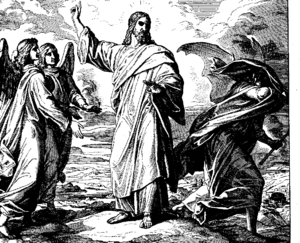- Matthew 4:10
-
 A 19th century woodcut by Julius Schnorr von Carolsfeld depicting the scene
A 19th century woodcut by Julius Schnorr von Carolsfeld depicting the scene
Matthew 4:10 is the tenth verse of the fourth chapter of the Gospel of Matthew in the New Testament. Jesus has rebuffed two earlier temptations by Satan. The devil has thus transported Jesus to the top of a great mountain and offered him control of the world to Jesus if he agrees to worship him. In this verse Jesus rejects this temptation.
In the King James Version of the Bible the text reads:
- Then saith Jesus unto him, Get thee hence,
- Satan: for it is written, Thou shalt worship the
- Lord thy God, and him only shalt thou serve.
The World English Bible translates the passage as:
- Then Jesus said to him, "Get behind me,
- Satan! For it is written, ‘You shall worship
- the Lord your God, and you shall serve him only.’"
For a collection of other versions see BibRef Matthew 4:10
Jesus refers to the devil as Satan, this is in contrast with Matthew 4:1 where he is called "the Devil." Calling Satan and ordering him away seems to end the temptation scene. Artists have often embellished this scene with Satan then plummeting from the mountain. Jesus again quotes scripture in response to the temptation, this time the quote is from Deuteronomy 6:13 which is on the Israelites rejection of idolatry. The verse changes the wording in the Septuagint from fear to worship, to better tie in with the temptation, and adds only at the end for added emphasis.[1]
Jesus repeats the phrase "Get behind me, Satan!" in Matthew 16:23, but that time it is Peter who referred to. The phrase is a well known one, symbolizing the rejection of temptation. This phrase does not occur in the version of this event at Luke 4:8, and the author of Matthew may have added it to draw parallels with the later Peter incident.[2] It has been used a number of times in art and literature, such as in the title of the album Get Behind Me Satan by The White Stripes. The expression itself "get behind me" is not inherently negative, and is used elsewhere in the Gospel for happily sending someone on their way.[3]
References
- ^ France, R.T.. The Gospel of Matthew. Wm. B. Eerdmans Publishing, 2007 pg. 135
- ^ Harrington, Daniel J. The Gospel of Matthew. Liturgical Press, 1991 pg. 67
- ^ France, R.T.. The Gospel of Matthew. Wm. B. Eerdmans Publishing, 2007 pg. 135
Gospel of Matthew Preceded by:
Matthew 4:9Chapter 4 Followed by:
Matthew 4:11Categories:- Gospel of Matthew verses
- Satan
Wikimedia Foundation. 2010.
